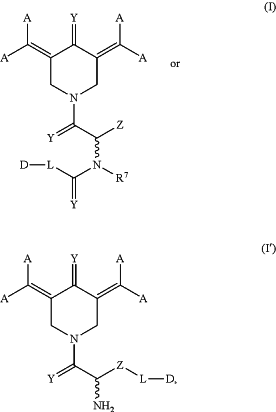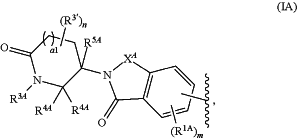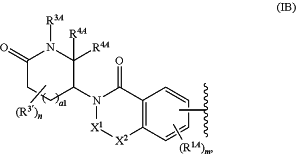| CPC C07D 401/14 (2013.01) [A61P 35/04 (2018.01); C07D 495/04 (2013.01)] | 20 Claims |
|
1. A compound of Formula (I) or Formula (I′):
 or a pharmaceutically acceptable salt, solvate, hydrate, tautomer, or stereoisomer thereof,
wherein:
in each pair of A's, one A is hydrogen, and the other A is one of:
(i) phenyl, optionally substituted with 1-5 substituents selected from the group consisting of R1, OR1, NR1R2, S(O)qR1, SO2R1R2, NR1SO2R2, C(O)R1, C(O)OR1, C(O)NR1R2, NR1C(O)R2, NR1C(O)OR2, CF3, and OCF3;
(ii) naphthyl, optionally substituted with 1-5 substituents selected from the group consisting of R1, OR1, NR1R2, S(O)qR1, SO2R1R2, NR1SO2R2, C(O)R1, C(O)OR1, C(O)NR1R2, NR1C(O)R2, NR1C(O)OR2, CF3, and OCF3;
(iii) a 5-or 6-membered monocyclic heteroaryl group, having 1-3 heteroatoms selected from the group consisting of O, N, and S, optionally substituted with 1-3 substituents selected from the group consisting of R1, OR1, NR1R2, S(O)qR1, SO2R1R2, NR1SO2R2, C(O)R1, C(O)OR1, C(O)NR1R2, NR1C(O)R2, NR1C(O)OR2, CF3, and OCF3; and
(iv) an 8- to 10-membered bicyclic heteroaryl group containing 1-3 heteroatoms selected from the group consisting of O, N, and S; and the second ring is fused to the first ring using 2 carbon atoms, and the bicyclic heteroaryl group is optionally substituted with 1-3 substituents selected from the group consisting of R1, OR1, NR1R2, S(O)qR1, SO2R1R2, NR1SO2R2, C(O)R1, C(O)OR1, C(O)NR1R2, NR1C(O)R2, NR1C(O)OR2, CF3, and OCF3;
wherein Y is selected from the group consisting of O, S, NR1 and CR1R2, and
wherein R1 and R2 are selected from the group consisting of hydrogen, nitro, hydroxyl, carboxy, amino, halogen, cyano and C1-C14 linear or branched alkyl groups, that are optionally substituted with 1-3 substituents selected from the group consisting of C1-C14 linear or branched alkyl, up to perhalo substituted C1-C14 linear or branched alkyl, C1-C14 alkoxy, hydrogen, nitro, hydroxyl, carboxy, amino, C1-C14 alkylamino, C1-C14 dialkylamino, halogen, and cyano;
wherein R7 is hydrogen, C1-6 alkyl, or a nitrogen protecting group;
wherein Z is selected from the group consisting of hydrogen; C1 to C14 linear, branched, or cyclic alkyl; phenyl; benzyl, 1-5 substituted benzyl, C1 to C3 alkyl-phenyl, wherein the alkyl moiety is optionally substituted with halogen up to perhalo; C1 to C14 linear or branched alkyl, wherein the alkyl moiety is optionally substituted with halogen up to perhalo; —(CH2)q—K, where K is a 5 or 6 membered monocyclic heterocyclic ring, containing 1 to 4 atoms selected from oxygen, nitrogen and sulfur, which is saturated, partially saturated, or aromatic, or an 8 to 10 membered bicyclic heteroaryl having 1-4 heteroatoms selected from the group consisting of O, N, and S, and wherein the variable q is an integer ranging from 0 to 4, provided that when the compound is of Formula (I′), Z is not hydrogen, and provided that when A is substituted with S(O)qR1, q is an integer ranging from 0 to 2;
L is a linker; and
D is an E3 ubiquitin ligase binding moiety,
wherein D is of the formula IA or IB:
 wherein:
XA is C(O) or C(R3A)2;
each R1A is independently halogen, OH, C1-C6 alkyl, or C1-C6 alkoxy;
each R3A is independently H or C1-C3 alkyl;
each R3′ is independently C1-C3 alkyl;
each R4A is independently H or C1-C3 alkyl; or two R4A, together with the carbon atom to which they are attached, form a C(O), C3-C6 carbocycle, or a 4-, 5-, or 6-membered heterocycle comprising 1 or 2 heteroatoms selected from N and O;
R5A is H, C1-C3 alkyl, or halogen;
m is 0, 1, 2 or 3;
n is 0, 1, or 2; and
a1 is 0 or 1; or
 wherein:
—X1—X2— is C(R3A)═N or C(R3A)2—C(R3A)2;
each R1A is independently halogen, OH, C1-C6 alkyl, or C1-C6 alkoxy;
R3A is H or C1-C3 alkyl;
each R3′ is independently C1-C3 alkyl;
each R4A is independently H or C1-C3 alkyl; or two R4A, together with the carbon atom to which they are attached, form a C(O), C3-C6 carbocycle, or a 4-, 5-, or 6-membered heterocycle comprising 1 or 2 heteroatoms selected from N and O;
R5A is H, C1-C3 alkyl, or halogen;
m is 0, 1, 2, or 3;
n is 0, 1, or 2; and
a1 is 0 or 1.
|